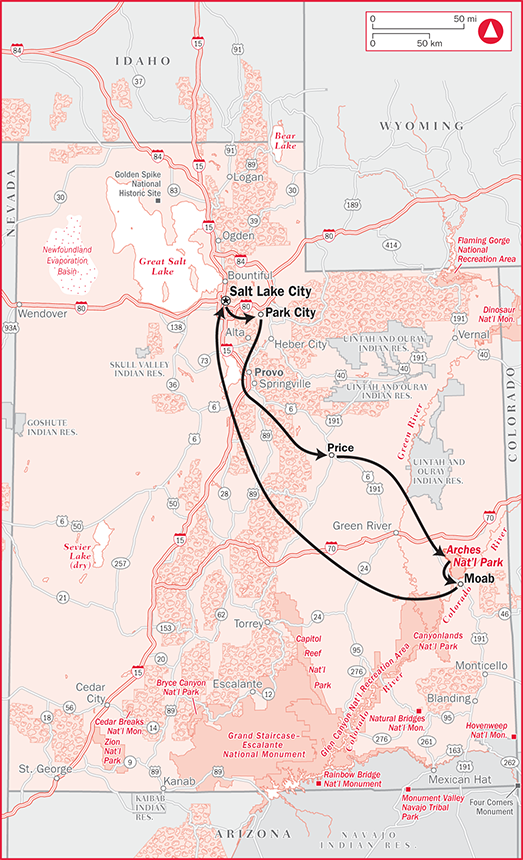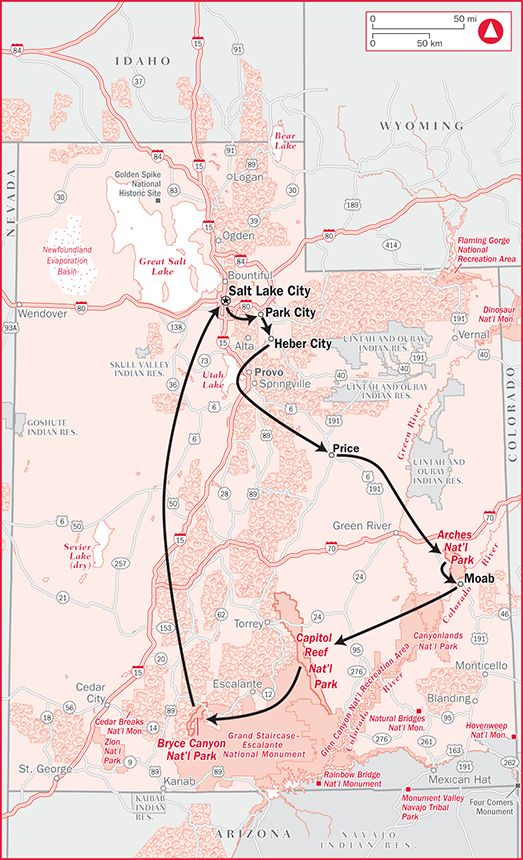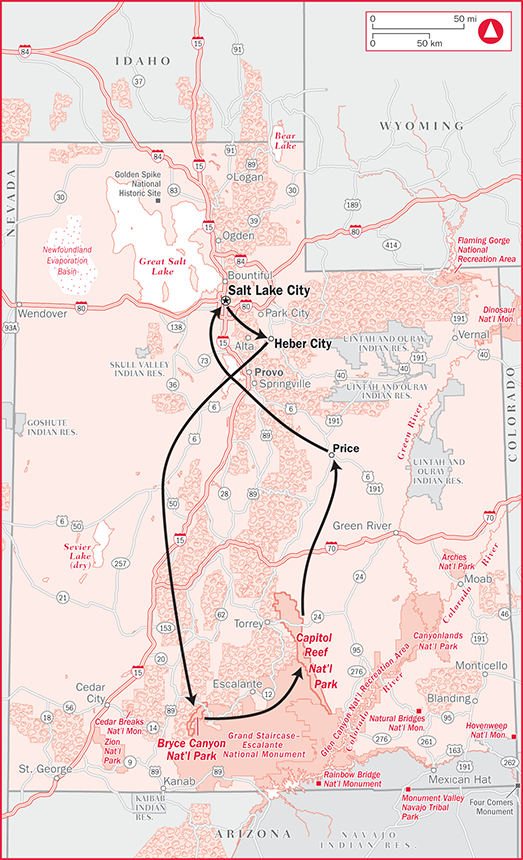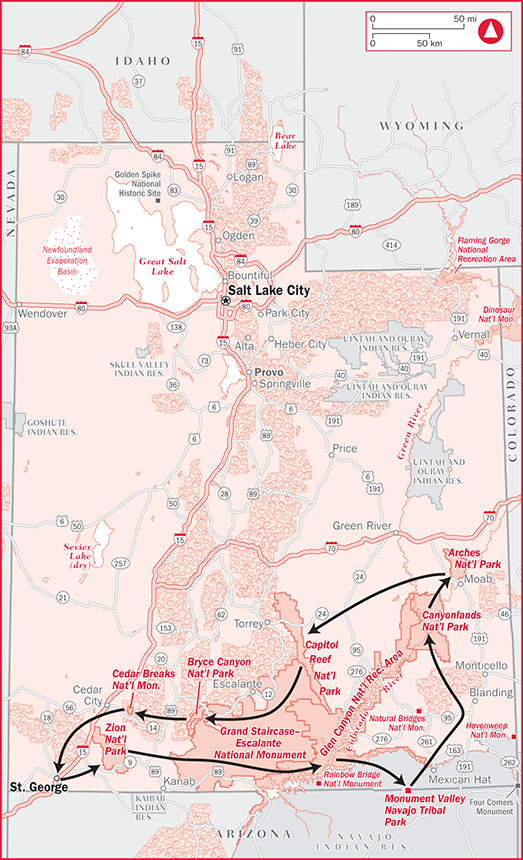Chapter 3: Suggested Utah Itineraries
Utah has so many worthwhile sights and attractions that you’ll want to keep coming back for more. Among the highlights of a trip to Utah are splendid national parks, ski resorts, and wilderness areas; the temples, tabernacles, and historic sites of the Church of Jesus Christ of Latter-day Saints; and genuine Old West destinations, from mining towns and steam trains to saloons and shootout locales.
Like most people, however, you probably have a limited amount of vacation time. This chapter spells out some recommended itineraries that plot out the most efficient routes to Utah’s must-see destinations, from a 1-week trip that squeezes in the best the state has to offer to more leisurely explorations for those with more time.
The following itineraries are all driving tours. If you plan to visit Salt Lake City only or head to a major resort to ski for a week, you can get by without a car, but most of the top destinations here—including all of the national parks—require a bit of a drive. Utah is a vast state, with its sights and attractions spread out, so you’ll end up doing some driving to get from one to another. One consolation is that traffic congestion is practically nonexistent, even in cities. Services along rural highways are often limited, though, so motorists need to keep an eye on fuel levels during long-distance hauls. That hand-painted roadside sign that says no gas next 50 miles may be more accurate than you think.
Utah in 1 Week
Utah in 1 Week

Nope, it can’t be done. There’s no way anyone can “see Utah” in only 7 days—there’s simply too much here that’s really worth exploring. But if 1 week it is, then try this fun, varied vacation that will give you a good taste of what Utah is all about. This trip starts and ends in Salt Lake City, taking in historic sites, Mormon culture, and some beautiful red-rock scenery along the way.
Days 1 & 2: Salt Lake City ★
Among Salt Lake City’s must-see attractions is Temple Square, the world headquarters of the Church of Jesus Christ of Latter-day Saints (LDS). In addition to the majestic church buildings, the square houses lovely gardens and statuary, and visitor centers with exhibits on the church’s history and beliefs. If possible, attend a performance of the renowned Mormon Tabernacle Choir. Then, before leaving the city, drop in at the Beehive House, built in 1854 as church leader Brigham Young’s family home, and the Church History Museum. See chapter 5.
Day 3: Park City ★★
Drive to the Old West mining town of Park City, where, in winter, you can test your skills at one of three fine ski resorts. In summer, stop at the Utah Olympic Park, built for the 2002 Olympics. It’s open year-round for tours and other activities. Next, go downtown to the Park City Museum—home to the old territorial jail in its basement (it’s worth a look)—and pick up a copy of the Park City Main Street Historic Walking Tour brochure, which leads you to 45 buildings and historic sites that have managed to survive the decades.
Day 4: Price
Make time for a stop in Price on your way south. The town began as a railroad and coal-mining center but is now best known for its dinosaurs. Stop at the CEU Prehistoric Museum, operated by the College of Eastern Utah, to see huge skeletons of an allosaurus, a Utah raptor, and an intriguing duck-billed dinosaur known as the prosaurolophus. If time permits, drive about 35 miles out of town to the Cleveland-Lloyd Dinosaur Quarry to see excavations and the bones of more than 70 dinosaurs.
Days 5 & 6: Arches National Park ★★ & Moab
One of Utah’s easiest-to-see national parks, Arches is prized for its mind-boggling sandstone rock formations. Explore its scenic drive and several trails, and you’ll delight in the otherworldly desertscape of natural stone arches, towers, and other fanciful sandstone formations. Make the adjacent town of Moab your headquarters, and take a break and cool off at the nearby Scott M. Matheson Wetlands Preserve, a lush oasis along the river that attracts more than 200 species of birds, plus river otters, beavers, and muskrats. See chapter 14.
Day 7: Back to Salt Lake City
It’s a long drive back to Salt Lake City, but, if time permits, plan a stop in Provo to explore some of its fine museums, especially the excellent Museum of Art on the campus of Brigham Young University, or the equally renowned Springville Museum of Art in nearby Springville.
Utah in 2 Weeks
Utah in 2 Weeks

Even 2 weeks is not enough time to see all that Utah has to offer, but in 14 days you will be able to see a bit more of everything. This tour assumes you’re flying in and out of Salt Lake City and renting a car. If, on the other hand, you don’t need to return to the state capital, you’ll have extra time to explore the national parks. The “Utah in 1 Week” itinerary provides the base for your trip.
Days 1 & 2: Salt Lake City ★
Start your adventure in Salt Lake City by following the first 2 days in the “Utah in 1 Week” itinerary.
Day 3: Park City ★★
It’s on to Park City, an Old West mining town. Follow the recommendations on day 3 of “Utah in 1 Week.”
Day 4: Heber Valley Historic Railroad ★★
A short, pretty drive from Park City, the 100-year-old excursion train in Heber City is your ticket to Utah’s past. Rides ranging from 1 1/2 to 3 hours are offered on both steam and vintage diesel trains.
Day 5: Price
On your way south, spend day 5 as described on day 4 of “Utah in 1 Week.”
Days 6–8: Arches National Park ★★ & Moab
Look to days 5 and 6 in “Utah in 1 Week” for suggestions on exploring the best of Arches National Park and Moab. If you have time, spend a day in Canyonlands National Park’s Island in the Sky District.
Days 9 & 10: Capitol Reef National Park ★★★
This well-kept secret offers brilliantly colored, unexpectedly shaped rock formations, along with a variety of historic sites and even an orchard. The Fremont River feeds a lush oasis in this otherwise barren land; in fact, 19th-century pioneers found the soil so fertile that they established the town of Fruita, named for the orchards they planted. Today you can explore the buildings and even pick fruit in season. Hikers should look for the rock wall where pioneers “signed in,” and explore canyons that were a favorite hide-out of famed outlaw Butch Cassidy. See chapter 12.
Days 11–13: Bryce Canyon National Park ★★★
It’s an amazingly scenic drive down Utah 12 to Bryce Canyon, where you’ll see thousands of intricately shaped hoodoos, those mysterious rock formations. Drive along the scenic route, stopping at the aptly named Inspiration Point. Then hit the colorful Queen’s Garden Trail, named for a formation that resembles Britain’s Queen Victoria, or take a leisurely stroll along the Rim Trail for some spectacular views. See chapter 11.
Day 14: Back to Salt Lake City
It’s a long drive back to Salt Lake City, but if time permits, plan a stop in Provo to explore some fine museums, especially the excellent Museum of Art on the campus of Brigham Young University.
Utah for Families
Utah for Families

Utah has the family-friendly thing down pat. Admission fees for children are especially low, and many tourist attractions offer family packages priced considerably lower than the per-person rate. Attractions frequently schedule family-centric events, and most destinations throughout this book have special activities for kids. This 12-day itinerary, which begins and ends in Salt Lake City, has plenty for the kids while also providing lots to interest the parents.
Days 1–3: Salt Lake City
Salt Lake City has so many family attractions that it would be easy to spend a week or more here. History buffs will enjoy exploring Temple Square and the Beehive House, built in 1854 as church leader Brigham Young’s family home. Other fun family stops include Clark Planetarium, offering star shows, light shows, and big-screen movies; Utah’s Hogle Zoo, home to 1,100 animals; and the kid-oriented Discovery Gateway, home to 140 exhibits of all kinds, including a kid-size grocery store and an outdoor “flight for life” exhibit. Another option is a day trip to nearby Ogden, for the Lagoon amusement park, the Treehouse Museum, or the terrific family attractions at the Salomon Center. See chapters 5 and 6.
Day 4: Heber Valley Historic Railroad ★★
This 100-year-old excursion train in Heber City provides an exciting look into the past, plus lots of black smoke, cinders, and wind in your hair. Rides ranging from 1 1/2 to 3 hours are offered on both steam and vintage diesel trains. Most kids, including the kids-at-heart, prefer the steam trains.
Days 5–7: Bryce Canyon National Park ★★★
This picturesque park is a long drive down I-15 and then along some back roads, but it’s well worth the trip. Bryce contains thousands of intricately shaped hoodoos—those brooding rock formations that pique the imagination—colored in a palette of red, orange, and brown. Kids will especially like hiking the Queen’s Garden Trail, where they can spot a variety of whimsical formations, such as Thor’s Hammer. See chapter 11.
Days 8 & 9: Capitol Reef National Park ★★★
Heading back north, take the incredibly scenic Utah 12 to Capitol Reef, a secret gem of a national park that offers brightly colored and oddly shaped rock formations, along with a handful of historic sites. Be sure to visit the 1896 Fruita Schoolhouse, authentically furnished with such period pieces as wood and wrought-iron desks, a wood-burning stove, and textbooks. Nearby, the orchards planted by the Mormon settlers continue to thrive, tended by park workers who invite you to sample the “fruits” of their labors. See chapter 12.
Day 10: Price
If you’re trying to sell children on a museum, make sure it has dinosaurs. Enter the CEU Prehistoric Museum, where huge skeletons of an allosaurus, a Utah raptor, and a duck-billed prosaurolophus preside. For the true dinophile, drive about 35 miles out of town to the Cleveland-Lloyd Dinosaur Quarry, where you’ll find relics of more than 70 dinosaurs.
Days 11 & 12: Back to Salt Lake City
Return to Salt Lake City and catch up on attractions you missed the first time, such as This Is the Place Heritage Park. The park is home to Old Deseret Village, a pioneer village comprised of original and reproduction buildings that, in summer, becomes a mid-1800s living-history museum, complete with costumed villagers and a variety of activities, including wagon rides. Another good choice is Liberty Park, with trails, a small lake with ducks and paddle-boat rentals, a playground, a children’s garden, a kiddie amusement park, a museum, and an excellent aviary. See chapter 5.
Utah’s National Parks
Utah’s National Parks

Southern Utah practically bursts its seams with five delightful national parks, plus a national recreation area and monument. In addition, the Navajo Nation is home to wondrous Monument Valley park, along the Arizona state line. Visit these sites in a somewhat circuitous loop for what may very well be the best national park tour in the American West. This trip begins and ends in St. George; air travelers will probably fly to Las Vegas, Nevada, and rent a car there. It can be done in 2 weeks, but is much more satisfying done in 3 weeks as described here. With extra time you can easily add the North Rim of the Grand Canyon (see Frommer’s Grand Canyon National Park, Wiley Publishing, Inc.).
Day 1: St. George
Stock up on supplies in town before heading to the parks, but also make some time for the St. George Dinosaur Discovery Site at Johnson Farm, which showcases some 2,000 fossilized dinosaur tracks. Other noteworthy attractions include historic Mormon sites, such as the Jacob Hamblin Home, built in 1862, which is typical of pioneer homes throughout the West except for its two identical bedrooms—one for each of Hamblin’s wives—and the exquisite 1876 St. George Tabernacle, with pine finished to look like exotic hardwoods, and even marble.
Days 2–4: Zion National Park ★★
Famous for its mammoth natural stone sculptures and unbelievably narrow slot canyon, this park begs to be explored. Hop on the shuttle bus that runs the length of the Zion Canyon Scenic Drive, getting off to take in the trails. Take the easy Riverside Walk, which follows the Virgin River down a narrow canyon through hanging gardens. Especially pleasant on hot days, the Lower Emerald Pools Trail traverses a forest of oak, maple, fir, and cottonwood trees, leading to a waterfall, a hanging garden, and a shimmering pool. See chapter 10.
Days 5 & 6: Glen Canyon National Recreation Area ★★★
This national recreation area is best known for Lake Powell and its 1,960 miles of shoreline. This is a boating destination, so you’ll want to either rent a boat to go exploring, fishing, or swimming, or take a guided boat trip. Whichever you do, be sure to save time for Rainbow Bridge National Monument, which is in the recreation area and easily accessible by boat. Believed to be the largest natural bridge in the world, this “rainbow turned to stone” is considered sacred by the Navajo.
Days 7 & 8: Monument Valley Navajo Tribal Park
To many of us, Monument Valley is the Old West we’ve seen in movies and on TV. Part of the vast Navajo Nation, the park has a 17-mile self-guided loop road that lets you hit most of the major scenic attractions, or you can get a more personalized tour with a Navajo guide. Either way, you’ll see classic Western scenery made famous in movies such as the 1939 classic Stagecoach, which starred a young John Wayne. Be sure to see the movie exhibits at Goulding’s Trading Post Museum.
Days 9–12: Arches ★★ & Canyonlands National Parks ★★
Beloved for its captivatingly beautiful red-and-orange rock formations, this area holds two national parks that flank the lively town of Moab. Canyonlands National Park is a hikers’ park. Stop at the Grand View Point Overlook, in the Island in the Sky District, and hike the Grand View Trail, which is especially scenic in late afternoon. Arches National Park is easier than Canyonlands to explore. Take the scenic drive and walk a few trails—on the Devils Garden Trail you can see 15 to 20 arches, including picturesque Landscape Arch.
Days 13 & 14: Capitol Reef National Park ★★★
This well-kept secret offers brilliantly colored rock formations with a bit of history. The Fremont River created a lush oasis in this otherwise barren land where 19th-century pioneers settled the town of Fruita, named for the orchards they planted. Today you can explore the town and even pick fruit in season. Hikers can examine Pioneer Register, a rock wall where traveling pioneers “signed in,” and explore canyons where famed outlaw Butch Cassidy is said to have hidden out between robberies. See chapter 12.
Days 15–18: Scenic Utah 12 & Bryce Canyon National Park ★★★
From Capitol Reef, go south on Utah 12 over Boulder Mountain and through Grand Staircase–Escalante National Monument; stop for a short hike to Calf Creek Falls before heading to Bryce Canyon National Park. Spend the night in the park or nearby so you can be on the rim of Bryce Amphitheater at sunrise—the best time to see the colorful and whimsical rock formations known as hoodoos. Top trails here include the colorful Queen’s Garden Trail, named for a formation that resembles Britain’s Queen Victoria. See chapter 11.
Days 19 & 20: Cedar Breaks National Monument ★
This small, high-altitude park has a 5-mile road that offers access to Cedar Breaks’ scenic overlooks and trail heads. Hike Spectra Point Trail along the rim for changing views of the colorful rock formations. The fields of wildflowers, especially colorful in late July and August, and the 1,500-year-old bristlecone pines are a real treat.
Day 21: Back to St. George
Back in St. George, catch the historic Mormon sights you missed earlier, or possibly take in a few rounds of golf at one of St. George’s eight splendid greens. If you want to see just one more park, drop in at one of Utah’s most scenic, Snow Canyon State Park, which offers an abundance of opportunities for photography and hiking.